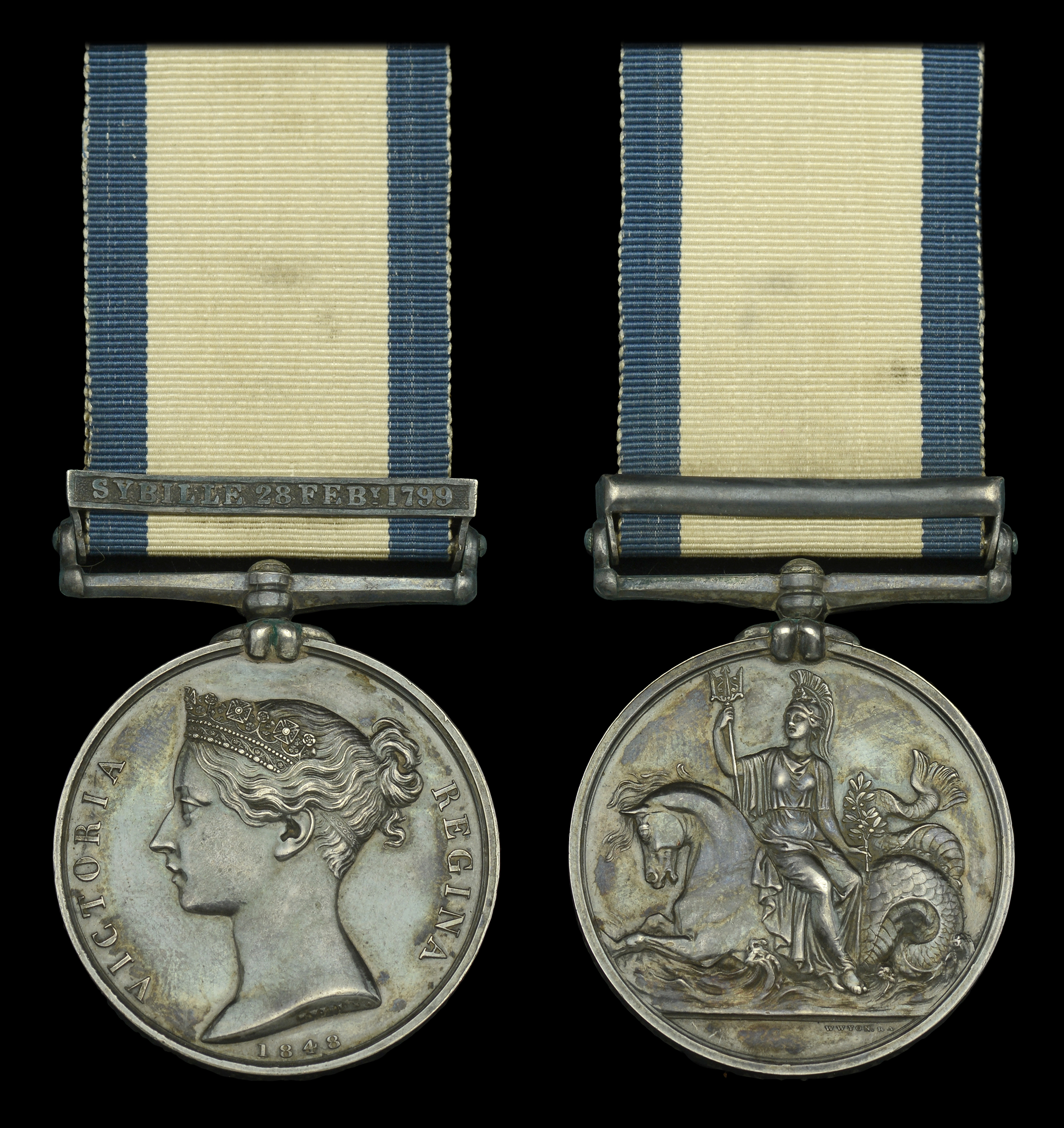The Naval General Service medal awarded to Commander William E. Wright, Royal Navy, who served as an Able Seaman in the Sybille 48-gun frigate at the capture, after a severe broadside-to-broadside contest, of the superior 52-gun French frigate La Forte in the bay of Bengal in February 1799 Naval General Service 1793-1840, 1 clasp, Sybille 28 Feby 1799 (William E. Wright.) original ribbon, dark toned, extremely fine £12,000-£16,000 --- Importation Duty This lot is subject to importation duty of 5% on the hammer price unless exported outside the UK --- --- Provenance: Peter Dale Collection, June 2000. Sybille 28 Feby 1799 [12 issued] - Samuel Butler, A.B. (Dix Noonan Webb, June 2020); Peter Cloosterman, Boy 2 Class; James Coombe, Ord.; Thomas Hurley, Ord. (Royal Naval Museum); James Long, Lieutenant R.N.; Arthur Lysaght, Midshipman; Nicholas Maunger, Lieutenant R.N. (Patiala Collection, Sheesh Mahal Museum, India); James Piercy, Supernumerary (National Maritime Museum); Robert Ratcliffe, Supernumerary; John Triggs, Ord.; Joseph Wright, Vol. 1st Class; William E. Wright, A.B. On 28 February and 1 March, 1799, Sybille took part in a furious engagement with the vastly superior French frigate La Forte, of 52 guns and 370 men, which, as part of the raiding squadron based at Mauritius, had been harassing British shipping in the Bay of Bengal. Having left Madras in search of La Forte two weeks earlier, Captain Cooke of the Sybille sighted the enemy frigate, one of the finest ever built, with two rich prizes, off the sand-heads of the Hooghly River at about 9 p.m. On closing with La Forte, the Sybille received a broadside from her larboard guns and a fire from one of her captures. Cooke brought the Sybille under the stern of the La Forte, ‘almost touching her spanker boom, and gave her the whole of her larboard broadside, and luffing up to leeward, poured in another broadside with the most destructive effect’. These broadsides killed and wounded between fifty and sixty of La Forte’s crew, and caused such confusion that her gunners fired from both sides of their ship at once. The two ships then engaged each other broadside to broadside. The French Captain and his First Lieutenant were both killed. Cooke of the Sybille was mortally wounded, and Lieutenant Hardyman took command. By two-thirty in the morning, fire from the French ship had been entirely silenced, and the Sybille hailed to ask if she had struck her colours. Receiving no reply, the Sybille recommenced firing. La Forte gave no return fire so once again the Sybille hailed her opponent, but again without response. The French were then seen attempting to make sail and escape. Sybille’s guns roared once more and within a few minutes the Frenchman’s mizzen mast was shot away, and his main and foremasts with the bowsprit sent overboard. Thus the action ended. The Sybille’s sails and rigging were cut to pieces and her main and mizzen masts badly damaged, but she had only received six shots in her hull. Captain Davies, who was an A.D.C. to Lord Mornington and a volunteer on board, was killed together with four other men. Besides Cooke, sixteen men were wounded, and though ‘a perfect wreck’, La Forte was taken into Calcutta for repairs and added to the Royal Navy as the Forte. William Elliot Wright entered the Navy as an Able Seaman in July 1798, on board La Sybille of 48 guns and 371 men. In that ship he was present at the capture, at the mouth of the Bengal river, of the French frigate La Forte of 52 guns and 370 men, after a dreadful action of two hours and a half, in which the enemy had 65 killed, including the Captain, and the British 5 killed and 17 (among whom was Captain Edward Cooke mortally) wounded. Acting Lieutenant of Caroline in December 1807 at the destruction, at Griessee in the island of Java, of the dockyard, stores, and all men-of-war remaining to Holland in India. Present in Donegal 15 November 1810, in an attack on two French frigates, the Amazone and Eliza, as they lay aground under the protection of several strong batteries near Cherbourg. In Royal Oak with the expedition to New Orleans 1814. Acting Commander of the Griffon sloop at St Helena and tried by court-martial in 1817 on a charge of smuggling fifty-three yards of crape and various other contraband articles, during the Griffon’s stay at Portsmouth. Sentenced to be dismissed the service but was subsequently restored to his former rank of Commander in 1819.





